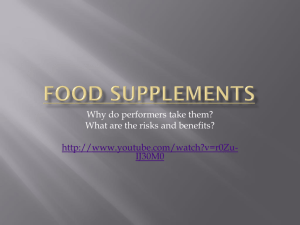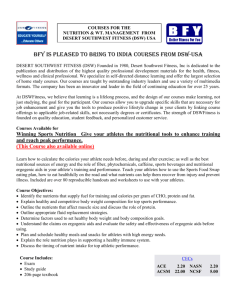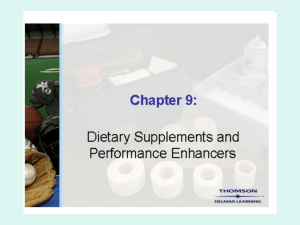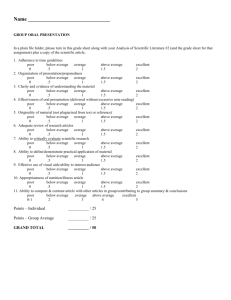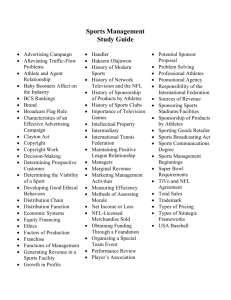Sports Nutrition & Supplements: Athlete's Guide
advertisement
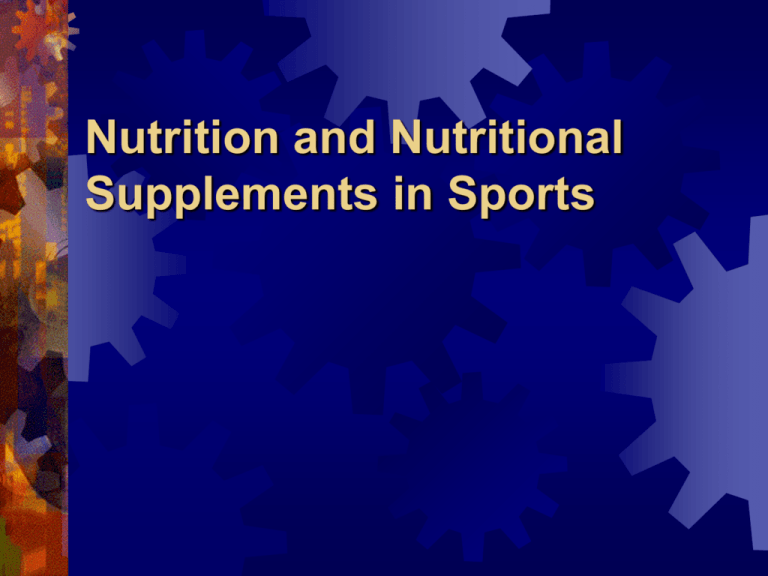
Nutrition and Nutritional Supplements in Sports Objectives Increase awareness that nutrition can affect an athlete’s performance Discuss current nutritional recommendations for athletes Review the 1994 Dietary Supplement Health and Education Act Discuss specific nutritional supplements commonly used by athletes Definition of a supplement Impact of this legislation Do they work? Are they safe? Review the Anabolic Steroid Control Act of 2004 Help providers answer questions and address concerns of athletes, parents and coaches Performance Influencing Factors Genetics Training Nutrition and Conditioning Determinants of the Athlete’s Energy Requirements During intense exercise Carbohydrate stored in muscles and liver (glycogen) is predominant fuel source During Fat prolonged exercise stores are predominant fuel source Fitness Well level of the athlete trained endurance athletes burn fat more efficiently, sparing limited glycogen stores Formula for Estimating the Body’s Calorie Requirements Sedentary person Moderately active person Weight (kg) x 40 Underweight person Weight (kg) x 30 Active person (endurance athlete) Weight (kg) x 25 Weight (kg) x 45 kg = lbs / 2.2 Activity for 30 min. 90 lbs. 100 lbs. 110 lbs. 120 lbs. 130 lbs. 140 lbs. 150 lbs. 160 lbs. 170 lbs. 180 lbs. 190 lbs. 200 lbs. Aerobics step training, 4" step (beginner) 131 145 160 174 189 203 218 232 247 261 276 290 Backpacking 180 200 220 240 260 280 300 320 340 360 380 400 Basketball (game) 198 220 242 264 286 308 330 352 374 396 418 440 Bicycling, 10 mph (6 minutes/mile) 112 125 138 150 162 175 188 200 213 225 237 250 Hiking, no load 140 155 171 186 202 217 232 248 263 279 294 310 Jogging, 5 mph (12 minutes/mile) 167 185 203 222 240 259 278 296 315 333 352 370 Raquetball 185 205 225 246 266 287 308 328 349 369 389 410 Running, 08 mph (7.5 minutes/mile) 274 305 336 366 396 427 458 488 518 549 579 610 Soccer 176 195 215 234 253 273 292 312 332 351 371 390 Swimming (25 yards/minute) 108 120 132 144 156 168 180 192 204 216 228 240 Walking, 3 mph (20 minutes/mile) 72 80 88 96 104 112 120 128 136 144 152 160 Weight training (40 sec. between sets) 230 255 280 306 332 357 382 408 433 459 484 510 Carbohydrates Non-essential nutrient (human body can make sugar) Simple (sugars) and Complex (starches) Major fuel source for exercising muscle Athletes should ingest 6 to10 gm/kg/day 60 to 70% of total calories should come from carbohydrates Complex carbohydrates (starches) are preferable During exercise Athletes should consume 25 to 30 gm of carbohydrate for every 30 minutes of exercise Athletes should drink 6 to 8 ounces of water or sports drink for every 10 to 15 minutes of exercise Carbohydrates After exercise Athletes should consume 1.0 to 1.5 gm/kg immediately post exercise and again one hour later To replace muscle glycogen stores To prevent gradual depletion of muscle glycogen stores over time caused by repetitive daily bouts of heavy exercise To decrease muscle breakdown Why Complex Carbohydrates? Compared to ingesting simple carbohydrates, ingesting complex carbohydrates: Increases muscle glycogen stores better Improves performance and delays fatigue Promotes faster stomach emptying Causes less stomach upset and indigestion Leads to lower blood sugar and insulin levels Provides other beneficial nutrients Fiber, vitamins and minerals Pre-exercise Meal Importance Less hunger before and during exercise Maintains optimum glycogen stores Recommendations Emphasize complex carbohydrates (starches) Avoid high fat and high protein foods 1 to 4 gm/kg about 1 to 4 hours prior to event Consume less closer to event Slower gastric emptying can cause stomach upset Avoid high fiber or gas forming foods Can lead to crampy abdominal pain Carbohydrate Loading Increases the body’s pre-exercise glycogen stores by 50 to 100% Benefits endurance athletes who compete for longer than 90 minutes Can increase endurance up to 20% Can increase performance by 2 to 3% Carbohydrate Loading: One Example of How Days prior to event Exercise duration 6 90 minutes 5 40 minutes 4 40 minutes 3 20 minutes 2 20 minutes 1 rest Carbohydrate intake 5 gm/kg/day 5 gm/kg/day 5 gm/kg/day 10 gm/kg/day 10 gm/kg/day 10 gm/kg/day Protein Athletes require more protein than non-athletes 12 to 18% of total calories should come from protein Protein intake should be tailored to type of training 1.2 to 1.4 gm/kg/day recommended for endurance athletes 1.7 to 1.8 gm/kg/day recommended for strength athletes Average American diet provides 1.4 gm/kg/day Adequate calorie intake is just as important as adequate protein intake for building muscles Too much protein intake can be bad Excess protein calories are stored as fat Excess protein intake can lead to dehydration and may contribute to kidney problems Fat Major source of energy 25 to 30% of total calories should come from fat Less than 10% of total calories should come from saturated fats Cholesterol intake should be less than 300 mg/day Average American diet provides 37% of total calories from fat Nutritional Supplements 1994 Dietary Supplement Health and Education Act Definition of a supplement Any product that contains vitamins, minerals, amino acids, herbs, botanicals or a concentrate, metabolite, constituent, extract or combination of any of these ingredients Removed dietary supplements from FDA regulation on the front end FDA must prove a supplement is dangerous before its sale can be prohibited Nutritional Supplements 1994 Dietary Supplement Health and Education Act Manufacturers do not have to provide scientific proof of claims Manufacturers cannot state product is meant to diagnose, treat, prevent or cure a disease but can make indirect suggestions Created a multi-billion dollar industry that continues to grow rapidly Vitamins and Minerals Essential nutrients No evidence in U.S. studies that taking vitamin and mineral supplements improves athletic performance Being deficient in vitamins or minerals is rare in the U.S. compared to the rest of the world A few studies outside U.S. showed an effect Human body needs these to produce energy Did population studied have some baseline deficiency treated with these supplements? Vegetarian athletes are at risk for being deficient in vitamins B12, D, riboflavin, iron, zinc and calcium Athletes who are strict vegetarians should take a multivitamin to prevent deficiencies and a calcium supplement (1000 mg/day) to help prevent bone loss Ephedra or MaHuang Herbal forms of the stimulant ephedrine 80 confirmed deaths related to ephedra use Experts suspect many more unconfirmed deaths Adverse effects High blood pressure (most common) Palpitations and increased heart rate Seizure Thermoregulatory dysfunction Stroke Heart attack Sudden death Vasculitis Allergic myocarditis (one case reported) Acute hepatitis (one case report) Ephedra or MaHuang Following the death of two professional athletes, FDA banned sale of Ephedra as a nutritional supplement Since this time, manufacturers have started substituting other stimulants Citrus Aurantium Orange extract Chemical structure very similar to ephedrine Anabolic Steroid Precursors Dehydroepiandrosterone (DHEA) and Androstenedione (“Andro”) Chemicals that can be converted into testosterone in human biochemical pathways Naturally available in wild yams An early study done by a manufacturer of these products showed no significant increase in blood levels of testosterone Study looked at lower doses of these supplements than are usually taken and did not measure ratio of testosterone to epitestosterone (T:E ratio) Anabolic Steroid Precursors Subsequent independent scientific studies DHEA Does not seem to have much if any effect on fat-free body mass and strength Androstenedione Causes a temporary increase in testosterone levels Has no effect on body’s ability to make protein Does not seem to have any effect on strength No long term effect on blood testosterone levels Chronic use causes increase in estrogen levels Anabolic Steroid Precursors Potential adverse effects May cause liver damage In females Can cause male features in women May increase risk of uterus cancer In males Can cause female features in men May increase risk of prostate cancer Anabolic Steroids and Anabolic Steroid Precursors Are banned and tested for by the USOC, IOC, NCAA, NFL, NBA and MLB NHL has no official policy and does not perform testing You can be disqualified from participating in college sports if you test positive for a substance banned by the NCAA Whether or not you knew it was banned Whether or not the product was mislabeled Buyer Beware! IOC funded study by Shanzer (Germany) from 10/00 to 11/01 Analyzed 634 products labeled as non-hormonal nutritional supplements from 13 countries and 215 different suppliers 94 products (14.8%) were found to be “positive supplements” (contained anabolic steroid precursors not declared on the label) Anabolic androgenic steroid concentrations ranged from 0.01 to 190 micrograms per gram of supplement 23 products contained steroid precursors of nandrolone and testosterone 64 products contained steroid precursors of testosterone only 7 products contained steroid precursors of nandrolone only Percentage of positive supplements per country 25.8% of products bought in Netherlands 22.7% of products bought in Austria 18.8% of products bought in UK 18.8% of products bought in US (45 positive out of 240 tested) Anabolic Steroid Control Act of 2004 Signed into federal law on October 22, 2004 Amends the Anabolic Steroid Control Act of 1990 Modifies the definition of anabolic steroids to include tetrahydrogestrinone (THG), androstenedione, and specified related chemicals Directs the U.S. Sentencing Commission (USSC) to review federal sentencing guidelines with respect to anabolic steroid-related offenses Amends guidelines to provide for increased penalties Authorizes the Attorney General to exempt from regulation any compound, mixture, or preparation containing an anabolic steroid that does not present a significant abuse potential Directs the Secretary of Health and Human Services to award grants for science-based education programs in elementary and secondary schools to highlight the harmful effects of anabolic steroids and to ensure that the NSDUH includes questions concerning the use of these drugs. Source: Library of Congress Conclusions Nutrition plays an important role in an endurance athlete’s ability to perform Proper nutrition in combination with sound and proven training techniques can help endurance athletes to maximize their genetic abilities Certain nutritional supplements have not demonstrated any performance benefit in studies Conclusions Certain nutritional supplements can have potentially dangerous side effects Further legislation is needed to address the dangers of some nutritional supplements Professionals in the community need to be resources of good information for athletes, parents and coaches Physicians Physician assistants Nurse practitioners Athletic trainers School nurses Dieticians References Bemben MG, Bemben DA, Loftiss DD, Knehans AW. Creatine supplementation during resistance training in college football athletes. Med Sci Sports Exerc 2001;33(10):1667-73. Bemben MG, Tuttle TD, Bemben DA, Knehans AW. Effects of creatine supplementation on isometric force-time curve characteristics. Med Sci Sports Exerc 2001;33(11):1876-81. Bosco C, Tihanyi J, Pucspk J, Kovacs I, Gabossy A, Colli R, Pulvirenti G, Tranquilli C, Foti C, Viru M, Vira A. Effect of oral creatinine supplementation on jumping and running performance. Int J Sports Med 1997;18(5):369-72. Fuentes RJ and Rosenberg JM. Athletic Drug Reference ’99. Durham (NC): Clean Data, Inc.; 1999. Green G. Innovations in Drug Testing. Presented at the American Medical Society for Sports Medicine Annual Meeting, Orlando (FL), April 2002. Haller CA, Benowitz NL. Adverse cardiovascular and central nervous system events associated with dietary supplements containing ephedra alkalloids. N Engl J Med 2000;343(25):1833-8. Jackson C. Vitamin and Mineral Use and Controversies for Strength Training. Presented at American College of Sports Medicine Annual Meeting, St. Louis (MO), May 2002. Jones AM, Atter T, Georg KP. Oral creatine supplementation improves multiple sprint performance in elite ice-hockey players. J Sports Med Phys Fitness 1999;39(3):189-96. Kreider RB, Ferreira M, Wilson M, Grindstaff P, Plisk S, Reinardy J, Cantler E, Almada AL. Effects of creatine supplementation on body composition, strength and sprint performance. Med Sci Sports Exerc 1998;30(1);73-82. Mihic S, MacDonald JR, McKenzie S, Tarnopolsky MA. Acute creatine loading increases fat-free mass, but does not affect blood pressure, plasma creatinine, or CK activity in men or women. Med Sci Sports Exerc 2000;32(2):291-96. References Romer LM, Barrington JP, Jeukendrup AE. Effects of oral creatine supplementation on high intensity, intermittent exercise performance in competitive squash players. Int J Sports Med 2001;22(8):546-52. Samenuk D, Link MS, Homoud MK, Contreras R, Theohardes TC, Wang PJ, Estes NA 3rd. Adverse cardiovascular events temporally associated with mahuang, an herbal source of ephedrine. Mayo Clin Proc 2002;77(1):7-9. Schanzer W. Analysis of Non-Hormonal Nutritional Supplements for Anabolic-Androgenic Steroids – An International Study. Available through the official website of the International Olympic Committee 2002. Schilling BK, Stone MH, Utter A, Kearney JT, Johnson M, Coglianese R, Smith L, O’Bryant HS, Fry AC, Starks M, Keith R, Stone ME. Creatine supplementation and health variables: a retrospective study. Med Sci Sports Exerc 2001;33(2):183-88. Syrotuik DG, Game AB, Gillies EM, Bell GJ. Effects of creatine monohydrate supplementation during combined strength and high intensity training on performance. Can J Appl Physiol 2001;26(6):527-42. Tarnopolosky MA, Parise G, Yardley NJ, Ballantyne CS, Olatinji S, Phillips SM. Creatinedextrose and protein-dextrose induce similar strength gains during training. Med Sci Sport Exerc 2001;33(12):2044-52. Poortmans JR, Auquier H, Renaut V, Durussel A, Saugy M, Brisson GR. Effect of shortterm creatine supplementation on renal responses in men. Eur J Appl Physiol Occup Physiol 1997;76(6):566-67. Rico-Sanz J, Mendez Marco MT. Creatine enhances oxygen uptake and performance during alternating intensity exercise. Med Sci Sports Exerc 2000;32(2):379-85. Wallace B. Hormone “Supplements” and the Strength Athlete. Presented at American College of Sports Medicine Annual Meeting, St. Louis (MO), May 2002. References Tarnopolosky MA, MacLennan DP. Creatine monohydrate supplementation enhances highintensity exercise performance in males and females. Int J Sport Nutr Exerc Metab 2000;10(4):452-63. Vahedi K, Domigo V, Amarenco P, Bousser MG. Ischaemic stroke in a sportsman who consumed MaHuang extract and creatine monohydrate for body building. J Neurol Neurosurg Psychiatry 2000;68(1):112-3. Vandebuerie F, Vanden Eynde B, Vandenberghe K, Hespel P. Effect of creatine loading on endurance capacity and sprint power in cyclists. Int J Sports Med 1998;19(7):490-95. Volek J. Nutritional Practices for Resistance Training. Presented at American College of Sports Medicine Annual Meeting, St. Louis (MO), May 2002. Volek JS, Mazzetti SA, Farquhar WB, Barnes BR, Gomez AL, Kraemer WJ. Physiological responses to short-term exercise in the heat after creatine loading. Med Sci Sports Exerc 2001;33(7):1101-8. Volek JS, Duncan ND, Mazzettti SA, Putukian M, Gomez AL, Kraemer WJ. No effect of heavy resistance training and creatine supplementation on blood lipids. Int J Sports Nutr Exerc Metab 2000;10(2):144-56. NCAA. 2001-02 NCAA Banned-Drug Classes. Available at URL: [http://ncaa.org/sports_sciences/drugtesting/banned_list.html]. Zaacks SM, Klein L, Tan CD, Rodriguez ER, Leikin JB. Hypersensitivity myocarditis associated with ephedra use. J Toxicol Clin Toxicol 1999;37(4):485-9. Nadir A, Agrawal S, King PD, Marshall JB. Acute hepatitis associated with the use of a Chinese herbal product, ma-huang. Am J Gastroenterol 1996;91(12):1436-8. http://www.usdoj.gov/ndic/pubs11/12620/steroids.htm
